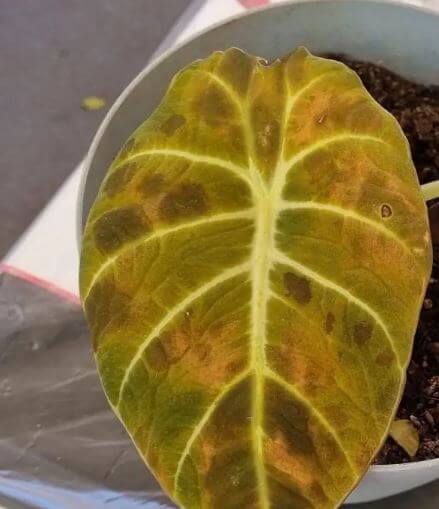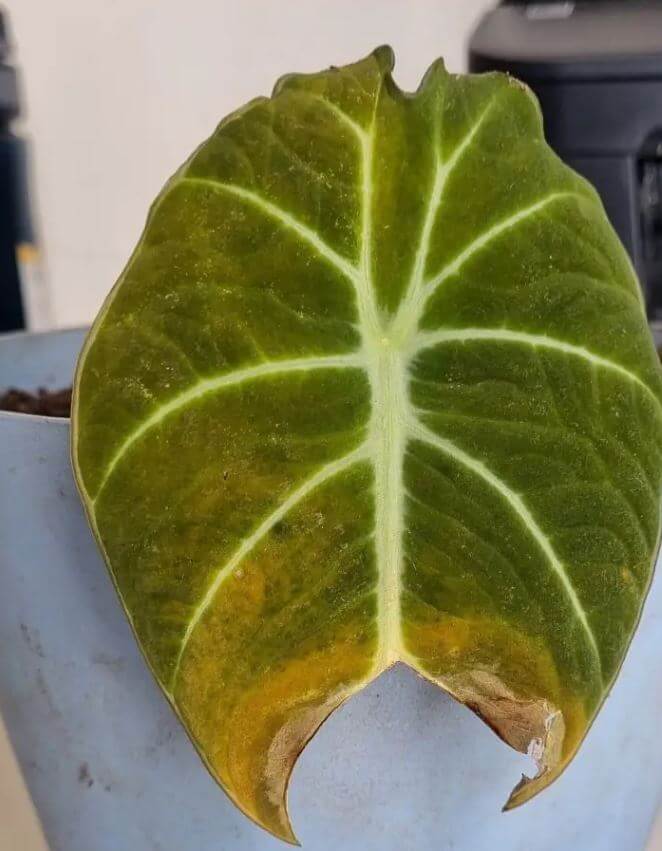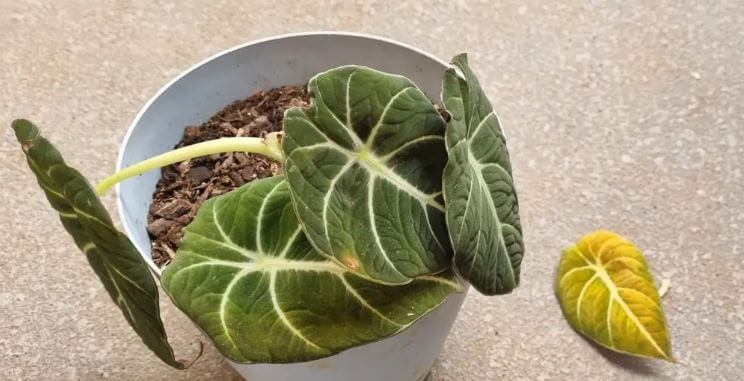Last Updated on June 19, 2023 by a Friendly Gardener
The Alocasia Black Velvet, botanically known as the Alocasia Reginula is a striking miniature alocasia that boasts stunning leaves in a deep forest green with contrasting thick white veins. Like all houseplants, if proper environmental conditions are not provided, this alocasia species can develop issues that include:
- Browning leaves
- Brown tips
- Brown or black spots
- Curling leaves
- Yellowing leaves
When an alocasia develops any of these conditions, it is a clear sign that the plant is in distress. Here is an in-depth look at each of these symptoms, why they appear, and what to do about them.
A Black Alocasia with Browning or Yellowing Leaves
Browning or yellowing foliage on a Black Velvet alocasia can be the result of several care problems including excessive exposure to sunlight, low environmental temperatures, low humidity, overwatering, and underwatering. Or your plant may just have entered dormancy.
-
Excessive Sunlight

The Black Velvet Alocasia is an understudy plant found on jungle floors that grow under canopies created by other vegetation and trees. If this plant is placed in the sun, it will scorch and burn rapidly, especially in warmer seasons. Place the Black Velvet Alocasia in a shady spot.
-
Low Temperatures
As a tropical plant, it requires a warm climate to thrive. This alocasia grows best in temps that remain above 70°F. They can survive temps as low as 60°F but should drop no lower.
-
Alocasia Black Velvet Humidity
Again, as a tropical, this species lives in tropical rainforests, so it needs higher humidity. Room humidity levels should be at least 50% or higher. If humidity is low in your home, use a space humidifier, or pebble tray to raise indoor levels.
-
Overwatering

The most common reason for discoloration of foliage is overwatering. Poor soil drainage can create the same issue. If you tend to overwater, it’s wise to use a moisture meter. If you have not watered for several days and your meter reads wet, you have an overwatering problem. Your plant can drown because oxygen no longer reaches root systems or fungal infections can take hold. Brown and yellow spots appear and then spread across the rest of the plant. Repot your plant in fresh soil and wait to water it.
-
Underwatering

In the case of underwatering, leaves will usually begin with brown leaf edges. Alocasia Black Velvet curling leaves will appear as dehydration worsens. Once leaves begin to brown due to the lack of water, they will never regain their original green color. Water your plant and consider pruning compromised leaves.
-
Alocasia Dormancy
When plants enter dormancy as a reaction to the winter, alocasia black velvet drooping will occur and discoloration will take place. Gradually leaves will fall off. If your Alocasia loses all its foliage, do not assume it is dead. It may just be asleep and will regenerate when environmental conditions return.
A Black Alocasia with Brown Tips
Brown tips usually indicate low humidity but can be caused by excessive fertilizing especially when container cultivated. If you note that your plant is developing brown tips, interrupt fertilizing and flush your plant’s soil but avoid wetting the leaves. Make sure flushing water is draining out of the bottom of your pot. To prevent brown tips from appearing, mimic the Black Velvet alocasia’s natural habitat by only watering when the top inch or so of the soil is dried out. Water only in small amounts.
Alocasia Black Velvet Brown Spots
Brown spots on Black Velvet Alocasia foliage are a result of fungal infections due to overwatering or poor drainage. Fungus gnats are another cause. They breed in overly moist soil. Plastic pots can contribute to excessively moist soil whereas clay or terracotta containers will aid in wicking excess moisture away. Leaves may begin to form yellow spots that with time turn a rusty brown. They spread until the entire leaf is covered in fungal growth. Eventually, the stems of affected leaves snap off.
Remove affected leaves. Consider repotting your plant in fresh, drier soil, and treat your plant with neem oil which is a natural fungicide.
Alocasia Black Velvet Curling Leaves

The most common reason for curling foliage is dehydration. You are not providing your Black Velvet Alocasia with enough water or humidity levels are too low. When this alocasia plant is underwatered, it will curl its leaves inward to reduce the foliage surface. This, in turn, limits light absorption because it does not have enough moisture to produce nourishment during photosynthesis. Dry air can cause leaf curling because there is insufficient humidity.
In the event of insufficient water, increase watering slowly and observe foliage for uncurling. If you live in an arid climate or have dry air in your home due to heating or air conditioning, consider investing in a space humidifier or try placing a pebble tray beneath the plant. An alternative is to move the plant to a bathroom or kitchen where the humidity is higher. Again, watch your plant for a positive reaction with uncurling.
Dormancy and Leaf Drop

If you feel that your care routine is correct but your alocasia is losing all its foliage, it is probably entering dormancy. All alocasia species will interrupt growing and die back as the weather cools. Daylight shortens and light intensity weakens. The Black Velvet Alocasia will store nourishment in its corms. Corms appear as small bulbs from which stems sprout when environmental conditions are proper.
If your plant loses all its leaves in the winter, don’t fret, and don’t toss the plant. It has entered dormancy. Reduce watering and move your plant indoors if you had it outside.
The Black velvet alocasia can also lose its foliage due to the soil bed surface sitting too high above the rhizomes and the corms. The corms grow baby plants, so if the soil is piled too high, new stems may not be able to emerge from the surface.
A Final Thought
If the area you live in does not have a climate similar to the tropics or with higher humidity levels, Black Velvet Alocasias are a challenge to care for. However, with good quality well-draining soil, a clay pot, a low soil surface level, partial shade and indirect light, moderate watering, and a humidifier, you should be good to go, and your alocasia should thrive.

